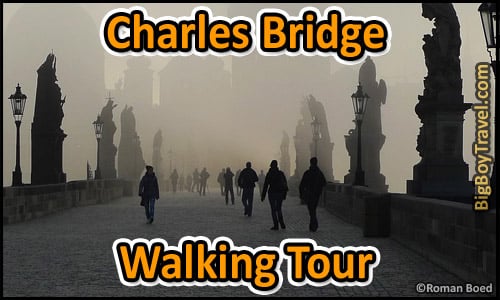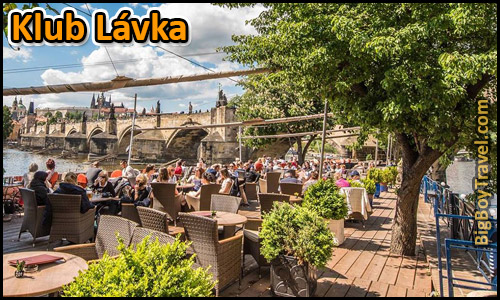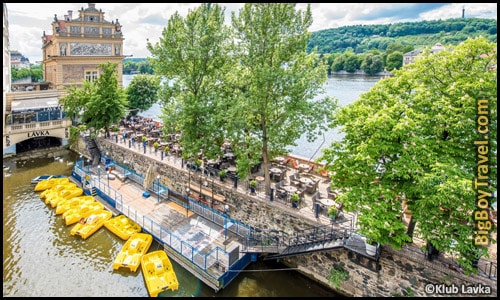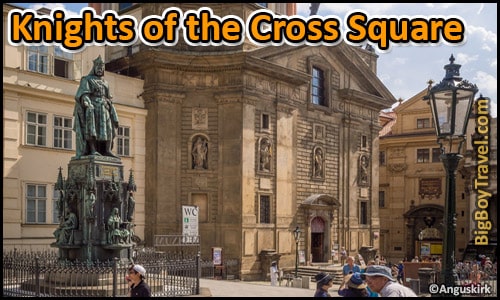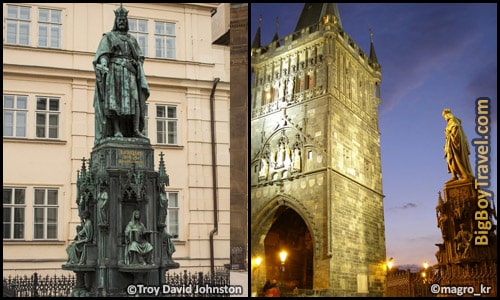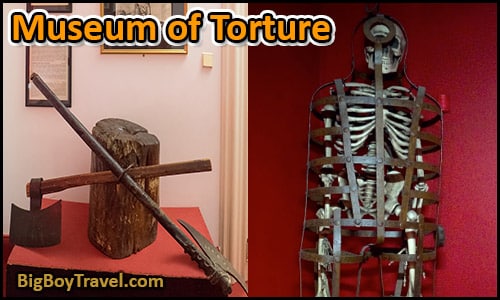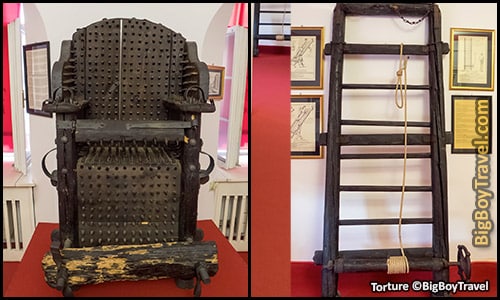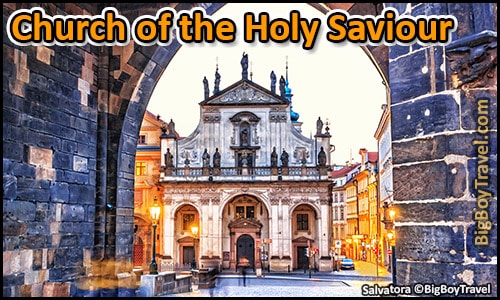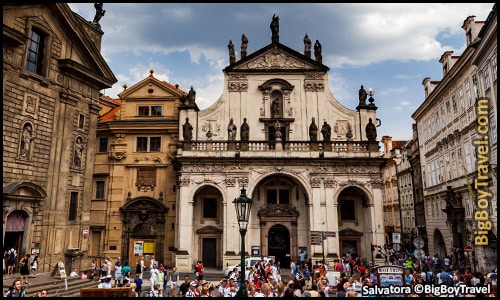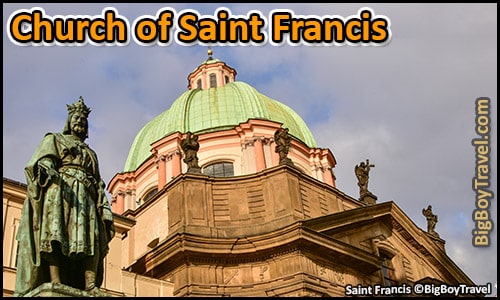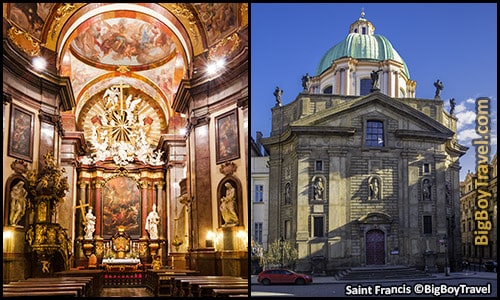Charles Bridge Statues Walking Tour:
Location: Charles Bridge (Karlov Most)
Cost: Free (optional costs below)
Style: Do-It-Yourself Walking Tour (Self Guided)
Start: Klub Lávka & Paddle Boats
End: The John Lennon Wall
Walking Distance: 1 Mile
Time: 25 Minutes for walk (with all sights 2+ hours)
Fun Scale: 10 out of 10
Charles Bridge Tour Overview:
Connecting Prague’s Old Town to the Little Quarter, the medieval Charles Bridge is one of the city’s most magical experiences. As you stroll across the Vltava RIver and inspect the many surrounding sights, you will instantly feel like you’ve traveled hundreds of years back in time. Because of the Charles Bridge’s central location, is it very easy to pair your walk with one of the surrounding neighborhoods which makes for an unforgettable day.
Charles Bridge Walking Tour Sights:
1. Klub Lávka & Paddle Boats:
About Klub Lávka: Klub Lávka is one of the best hidden gems in Prague, even though it is clearly visible to anyone crossing Charles Bridge. This huge river level Cafe & Nightclub Amazing is known for its scantily clad dancing girls at night, but we love it for the cafe patios. The long outdoor patio sits right at the base of Charles Bridge offering what may be the best views in town of the historic bridge. While it is suggested to get a reservation ahead of time, the patio is large enough for 250 people and seems to have a least a couple tables open all the time. If you can a little extra time, and on-site paddle boat rentals are a real treat. You can even make your own booze cruise by smuggling a couple beers one with you.
Night Club Cost: 18+ nightclub has a 100 CZK cover after 9pm. Klub Lávka Hours: It is open from 8am-4am. Cafe Website: (HERE).
2. Knights of the Cross Square:
About Knights of the Cross Square: The cozy square surrounding Old Town Bridge Tower is packed with history. The square gets its Czech name Křížovnická Namesti from order of Knights of the Cross with the Red Star (formerly the Franciscan Brotherhood), who until 1342 guarded the previous bridge called Juditin Bridge and collected tolls from crossers. The Knights had gained power in the 1200’s from the Catholic Church through numerous Crusades which awarded them extensive possessions in both Prague and greater Bohemia. The main street Křížovnická which leads from the Square to the Rudolfinum in the North is also named after the Knights.
As you inspect the Knights of the Cross Square closer, the first thing to examine is the centrally located bronze statue of Emperor Charles IV. The statue was completed in 1848 on the 500th anniversary of Charles University and shows Emperor Charles boldly leaning on his sword while holding the deed to the University in his other hand. From the central statue, it is the easiest to see the sights over our new few walking tour stops counter-clockwise starting on the South end of the Square.
3. Museum of Medieval Torture Instruments:
About The Museum of Medieval Torture Instruments: One of two museums of Medieval torture instruments in Prague which give you a truly fascinating peek into the brutal reality of life in Europe’s Middle Ages. During Medieval Times people were mainly tortured after committing crimes, but it also came as punishment for not agreeing with the Royal family or the Church. Even when no crime was committed some of the torture was for sport and some were done to innocent people to be made an example of in order to maintain the citizens’ fear-based obedience.
The museum itself has over 60 “authentic” devices on display with detailed descriptions in both Czech and English. We found that they don’t really need description at all as each instrument is also coupled with a vivid painting showing how the torture items were used. The museum is a bit cheesy and not as good as other famous ones in places like Rothenburg Germany, but it is interesting. Among the craziest items on display the Judas Cradle where the victim would be put by the anus on top of a pointed wooden pyramid while pulled by weights slowly impaling them. The Iron Maiden is one of the more famous devices which was a standup sarcophagus filled with spikes when closed would puncture the body while missing vital organs leading to a slow painful death.
Not all of the instruments were meant for maiming as there were also plenty of devices used for small crimes and humiliation in the Middle Ages. The humiliation devices on display at the Museum include devilish Pig Masks and heavy Iron Boots that would be locked onto citizens they wanted to be shamed. Many of these types of devices also included noisy bells to draw attention to the affected parties.
Torture Museum Hours: Daily 10am-8pm. Torture Museum Cost: 200 CZK; cash only. Website: (Here). Alternative Option: This museum can get a little crowded and is a little expensive compared to the quality. There is a similar cheesy, but larger torture museum near Old Town on Celetná Lane if you pass this one before it opens.
4. Church of the Holy Saviour (Salvatora):
About Church of the Holy Saviour: Sitting on the far East side of the Square is the Church of the Holy Saviour which served as Prague’s Mint until 1861 when it was turned into a church. The church is now part of the National Library (Clementinum) complex which we will cover as stop number 5. Turning all the way to the South side of the Square is the very interesting Museum of Medieval Torture Instruments which brings you into the reality of the harness of Medieval life.
5. Church of Saint Francis of Assisi:
About Church of Saint Francis: Towering above the Bridge Museum is the green and pink dome of the enticing Saint Francis of Assisi Church. The bright colors of the Churches dome stand in starch contrast the the brown stone facade filled with statues of Bohemian patron saints. It is this very spot that Saint Agnes of Bohemia established a Franciscan Hospital here in 1233. The the local Franciscan Brotherhood morphed into the Knights of the Cross with the Red Star they were given the hospital to base their operations and quickly turned it into a Catholic church. Together with the Archbishop of Prague the Knights rebuilt the property as the current beautiful church in 1688 and the hospital was moved one block North.
Make sure to take a peak in the inside as the surprisingly bright interior is chock-full of amazing paintings and religious ceiling frescoes. Although the church only has a seating capacity of around 100 they have done a great done creating a rich and elegant appearance with tons of gold gilding on the pulpit and ornate painting frames. Before moving on from St. Francis check out the large Vine Column from 1676 on the right corner of the church. This column is all that is left from the Wine Bureau which regulated the Prague’s wine industry and vine growing from Square from 1358 to 1783. The figure on top of the column is Saint Wenceslas who is the Patron Saint of Wine in Prague.
Church Website: (HERE).
6. Charles Bridge Museum: Sitting directly behind the statue of Saint Charles is Charles Bridge Museum opened in 1992 on the 650th anniversary of the Bridge’s opening. The museum is nondescript on the outside but holds a lot of history and artifacts from the area surrounding the St Charles Bridge through Medieval times. If you are standing in front of the Museum looking out toward the water, peek over the edge and notice the sculpture of a bearded man’s face sticking out of the river wall. It is believed that this sculpture was added during the 1800s and is the face of the man how built the previous Judith Bridge in the 1100s.
Bridge Museum Hours: Daily 10am-6pm, open in Summer until 8pm. Bridge Museum Cost: 150 CZK, Buy the 4-in-1 ticket. Its price includes the cruise through Prague Venice, entrances to the Charles Bridge Museum, and the Little Quarter’s Museum of Alchemists and the Mysteriae Pragensis Museum. Museum Website: (HERE).
7. Old Town Bridge Tower: As you reach the Old Town side of St Charles Bridge you’ll be struck by the dark Gothic tower built in 1373 as a gate and wwatchtower for the city. The tower was part of a fortification built around Old Town to protect it from invaders and it is still as imposing today. An older sister tower gate sits at the other end of the bridge toward Lesser Town and two other towers are later on this walking tour.
Over the years this historic Tower held the heads of Protestant leaders executed in Old Town Square in 1621 and was also the site of the last conflict of the Thirty Years War in 1648. After admiring the nearby statue of St Vitus, consider hiking up the Tower’s 138 narrow steps to the upper gallery for some unbeatable views of the Vltava River and St Charles Bridge. Upper Gallery Hours: Open Daily from 10am-10pm; Closes as early as 6pm in the Winter.
8a. The Charles Bridge (Karlův Most): Spanning the Vltava River between the Little Quarter and Old Town, Prague’s medieval Charles Bridge is one of our favorite bridges in Europe. The tantalizing Charles Bridge was finished in 1357 replacing Prague’s first stone bridge, the Judith Bridge. Wiped out by flooding in 1342, Judith was a Roman-style bridge originally built in the early 1100s and segments of it can still be seen in the basements of local houses. While the newer Charles Bridge may by pedestrian only now, in the Middle Ages it served as a bustling gateway into Old Town Prague. It was common to see the 1700 foot long cobblestone bridge filled with carriages, gypsies, and colorful merchants selling everything from gingerbread, swords, to sausages. Interestingly, the name Charles Bridge wasn’t added until the 1800s when it was named after the Emperor Charles IV. During his rule of Bohemia in the mid-1300s, Emperor Charles was also elevated to Holy Roman Emperor which brought great power to Prague.
8b. Charles Bridge Statues: The most charming thing about the Saint Charles Bridge is its 30 beautiful statues that give the Old World bridge a very Gothic appeal. As Prague’s main bridge in the Middle Ages, the City added the statues starting in 1683 as a way to show Prague’s power and sophistication. As beautiful as they are, the original statues were all moved to the Czech National Museum in 1965 to preserve them and were replaced by near-perfect replicas. While each statue is interesting, let us give you a brief overview of the main highlights in the order you’ll see them.
The first major statue you’ll see is the Lamentation of Christ which sits where a large wooden cross once stood before it was wiped out by the 1496 flood. The statue shows Virgin Mary and Mary Magdalene mourning a fallen Jesus beneath a resurrected Jesus and cross. Sitting directly across from the Lamentation, the Crucifix and Calvary statue is one of the most photographed ones on St Charles Bridge. It shows a large crucified Jesus flanked by the Virgin Mary and John Evangelist and details with golden Latin symbols.
One of our favorite statues is the one of Saint John the Baptist holding a golden cross and pointing the way down Kings Road. It’s fitting that the St John statue is here as prior to it there was a different one showing the baptism of Jesus. This is a great photo opportunity with the mighty Prague castle in the background that you just can’t pass up. If you are really into photography consider getting to the bridge during the early morning fog while the street lamps are still on or closer to dusk when St Charles is void of tourists and had perfect lighting.
Halfway down the bridge, you’ll see a rod iron marker between two statues indicating the spot where the Catholic Martyr Saint Neopomuk was drowned in the Vltava River in 1383. Neopomuk refused to give secrets from the Queen’s confessions to the King he had promised to stay silent on and was sentenced to death. Legend says that as John died 5 stars appeared around him representing Tacet, the Latin word for silence. The 5 stars have since become the symbol for the St John of Neopomuk and appear not only above his head on the plaque but also on the decorative cross marking his death on the railing. It is said that if you make a wish with your fingers touching all 5 stars of the railing cross at once it will come true. Notice the cross’ polished appearance from all the daily rubbing? Next to the marker is a much large statue of Saint Neopomuk, complete with a 5-star halo and two additional panels of scenes from his life you can rub for good luck. This is also a very popular place for visitors to leave love locks on the railing of the bridge.
Directly across from Saint Neopomuk was originally a statue of Saint Wenceslas which was replaced by one of his grandmother Saint Ludmila after it fell into the river. Ludmila is depicted teaching her young grandson, and future King, to read the bible. Future down is another statue featuring a woman called the Dream of St. Luthgard which was sculpted by the famous artist Matthias Braun in 1710. It is one of the bridge’s only marble statues and shows the vision the Catholic nun Luthgard had of Jesus coming off the cross and her kissing his wounds.
The John of Matha, Felix of Valois, and Saint Ivan statue is the largest and most expensive statue on the bridge. It shows John and Felix, who was known for buying and freeing Christians in captivity by non-Christians. Below the statue is a grated cave with 3 slave Christians inside praying for Salvation. Just across the bridge is the statue of the Roman Saint Vitus which shows lions approaching to get him before he was martyred for his faith. The huge cathedral at Prague Castle was also named in Vitus’ honor.
At the very end of the bridge where the Saint Wenceslas (Patron Saint of Prague) statue sits today, there were actually little permanent Medieval houses in the 1500s including Prague’s Customs Office. In 1714 this also became the spot for Prague’s 1st cafe when a Syrian coffeemaker saw the opportunity to bring his Middle Eastern delights to the city. His Turkish coffee was a huge hit and he quickly expanded from his small merchant cart to a wooden shack at the end of the bridge called the Kafírna Cafe. From the wooden shack, he expanded again into the larger living quarters of the Customs Office. Imagining what the bridge was like during merchant days really helps to give the Medieval feel.
9. The Devil’s Stream (Čertovka): While crossing Kampa Island on St Charles Bridge, the view to the South called Devil’s Stream is a favorite among photographers. The brightly colored house clings to the edge of the curved canal before disappearing around the corner. Legend has it that the man-made canal got its name from a mean lady who lived on it in the 1600s. Local kids thought she was wicked and they painted 6 devil figures on her door. The house then became known as At the Seven Devils with 6 on the door and the mean lady being the 7th. Photos of the Devil’s Stream are amazing from St Charles Bridge at dusk right when the street lamps start to reflect on the water. There are a bunch of ghost walking and boat tours that highlight different ghosts said to haunt the stream after dark. You will get a close look at the canal at the end of this walking tour.
10. Lesser Town Bridge Towers: Out of all the large Medieval towers around Prague, the Lesser Town Bridge Towers are by far our favorite. As you walk the last leg of the St Charles Bridge, it is easy to be drawn to the mighty twin towers like a magnet. The smaller of the two, known as Judith Tower, was built into the Lesser Town wall as its main gateway back in 1158. Shortly after the tower was built the Judith Bridge was also completed to connect Lesser Town to Old Town Prague. The Judith Bridge was ruined by flooding in 1342 before being replaced with St Charles Bridge, but the Tower remained strong. For the next 250 years, Judith Tower’s basement was turned into a high-security prison until the build was converted into a customs house in 1591 and turned into its current Renaissance style. The old customs house still sits right next to Judith Tower and holds one of the Tower’s original Gothic reliefs from the 1300s showing a man kneeling at the throne and getting a gift from the King.
Directly connected to Judith Tower by an arched walkway, the nearly 150-foot-tall Lesser Town Tower was built by King George of Podebrady in 1464. King George was already in the middle of greatly expanding Prague Castle at the time and wanted Lesser Town to have a mirror image of Old Town’s bridge tower which was completed 91 years earlier. We love this tower and urge you to check out its gallery and exhibit about towers located 85 feet up a fight of steps. Make sure to actually pass through the tower gateway and check out the banners hanging on the other side. Each banner is from a country that Bohemia ruled under the reign of King Wenceslas IV.
11. Míšeňská Street: As you leave the Lesser Town Bridge Towers toward Míšeňská Street consider taking a food break at one of the charming outdoor restaurants. Also, make sure to inspect the Four Maidens Statue street lamp in the middle of the road. We love walking just past it and taking photos of the lamps with the huge medieval tower in the background. After turning onto Míšeňská Street you’ll notice it is kind of like the land-based version of the Devil’s Stream with tightly packed colorful following a curved cobblestone lane. If you place your camera right at ground level you can get an excellent photo down the unique lane complete with the detail of the cobblestones.
At the very end of Míšeňská Street, consider popping into Vojan Park if the gate is open. The Park was built for the monastery of the Order of the Carmelitans in the 1200s making it one of Prague’s oldest parks. In 1660 they added the small, black cave-like St. Elias Chapel which is kind of cool. Near the Westside of the park the Church of St. Joseph at Lesser Town was built in 1686 for the women of Carmelites Convent. The park is one of the oldest in Europe as it was formed in 1300.
12. Pissing Fountain: Our favorite modern element in Prague is artist David Cerny’s Pissing Fountain at the Franz Kafka Museum. The fountain features to bronze male figures peeing into a pool in the shape of the Czech Republic. The figures’ hips swivel while their man parts move up and down allowing them to write messages in the pond with their pee. The standard streams of water write quotes from famous Prague residents, but you can have them write your message too. If you text a message to (+420) 724370770 the statues will spell it out with their pee which is quite amusing. The artist David Cerny has many playful statues around Europe including huge babies climbing the largest TV tower in Prague. Another popular installation of Cerny’s is at Prague’s Future Art Museum and is made of 2 large bodies bent over spreading their cheeks. You can climb a small ladder and peek into the butts at artistic videos playing inside.
Opening Hours: Daily 10am-6pm. Museum Entrance Fee: 200 CZK Adult, 120 CZK Students & Seniors, 540 CZK Family Ticket. You can usually see the Peeing Statue in the courtyard without paying to go into the museum. Website: (HERE).
13. Na Kampě Street: At the foot of St Charles bridge, the main curved road with colorful houses called Na Kampě Street (On Kampa) is a favorite among photographers. The street is especially beautiful as lamps light it at night and over the holiday season when it is filled with Christmas carolers. During the day there are a number of small outdoor restaurants with plenty of shade to rest your feet.
14. Liechtenstein Palace: The small Liechtenstein Palace looks pretty basic, but it dates back to 1696. Look above the door at the amazing stone coat of arms of the Princely House of Liechtenstein made in the 1800s. Sitting directly across from the Palace is the Embassy of Estonia inside the House At Blue Fox built in 1605. The door of the Embassy has a weird image above it with a Blue Fox holding a red rose in its mouth below a baby Jesus. If you wish to explore the Kampa Island future the Modern Art museum is pretty good, open daily from 10am-6pm, and costs 160 CZK.
15. Love Lock Bridge: One of the most lasting activities to do while traveling with your loved ones is to leave a Love Lock. Throughout Europe, there are several bridges where tourist leave paddle locks before throwing the keys into the River as a sign of their love lasting forever including this small bridge in Prague. The railings actually fill up so fast that the city ends up having to occasionally remove the locks because of how heavy they get. Some local residents don’t like the practice as they see it as an eyesore, but we find it to be very enjoyable. Overall cities like Prague and Paris have before seemed to embrace the trend as you will even see some tourist stands selling locks. We suggest bringing your own ahead of time and writing either your initials or a warm message on the lock before placing it.
16. Grand Priory Water Mill (Velkoprevorský mlýn): Opened in 1597 to replace a previous mill, the Grand Priory Water Mill got its name because it was owned by the Knights of Malta. While this is 1 of the only 3 mills still remaining on Kampa Island, originally there were dozens lining the canal. For the most part, the entire island was only mills and gardens until homes started popping up in the 1600s. This mill was sold by the Knights in 1795 it ran the longest before finally closing in 1936. Probably the coolest feature of the old water mill is its creepy-looking Water Sprite figure at the foot of the dock. This Water Sprite is from a Solvac fairytale and a common guarding among mills in Medieval Prague. It is said that fishermen would toss a little tobacco into the water as an offering for good luck from the pipe-smoking sprites. If the mills really interest you, consider heading to the Mlyn Hut on the Southwestern corner of the island which was part of a smelter mill when it was made in the 1400s.
17. John Lennon Wall: You might think that Prague is a strange place for a huge graffiti wall memorial for the former Beatles member John Lennon, but it is actually the perfect place. When Lennon was murdered in 1980 his songs and messages of freedom struck home with the youth of Prague who was smothered by oppressive Communist rule. It didn’t take long for young people to start painting this wall with messages of peace, hope, and freedom in protest of their Communist rulers. Since Prague’s citizens weren’t even allowed to listen to Pop music you can understand there was a very high risk of getting arrested while painting the wall. The movement grew and grew until finally in 1989 the non-violent Velvet Revolution ended the Communist rule in Czechoslovakia and led to Democracy. Today the same Knights of Malta that once owned the Grand Priory Mill, now own the Wall and support preserving it.
Other Sights Near Charles Bridge:
18. Old Town Walking Tour: The central heart of Prague is the highlight of our Old Town Prague Walking Tour. If you have enjoyed the Jewish Quarter, then you are surely going to fall in love with Old Town. Make sure to follow our free walking tour to get the full experience and including all of the neighborhood’s best-hidden gems you would miss otherwise.
19. Lesser Town Walking Tour: Lesser Town, also known as the Little Quarter fills the Western bank of the Vltava River tucked under the shadow of the historic Prague Castle. Many tourists only briefly walk through Lesser Town on their way to the Castle and miss out on a bunch of great sights. Our free walking tour of the Little Quarter will help make sure you get the most out of your visit.
20. Jewish Quarter Walking Tour: Prague Jewish population has been living in the small neighborhood known as Josefov for over 100 years before the City of Prague was even officially established. Over the centuries there have been both good times and conflicts that have forged together into a rich Jewish history. Filled with beautiful synagogues, a gnarly cemetery, and many other worthwhile attractions, a walk through the Jewish Quarter in Prague is a very worthwhile couple of hours.
21. New Town Walking Tour: In 1348, King Charles IV established New Town Prague which greatly expanded a City that was overflowing the walls of Old Town. New Town is centered around the very long, almost boulevard-like, Wenceslas Square which has an important place in Czech history. It is here where the peaceful Velvet Revolution took place in 1989 which helped to end Communist rule. Within just a couple blocks of Wenceslas Square are a number of great sights that we highlight on our free New Town Walking Tour.


